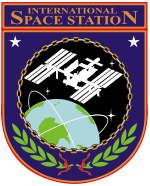ISS-Expedition 25
| Missionsemblem | |||
|---|---|---|---|
 | |||
| Missionsdaten | |||
| Mission: | ISS-Expedition 25 | ||
| Besatzung: | 6 | ||
| Rettungsschiffe: | Sojus TMA-19, Sojus TMA-01M | ||
| Raumstation: | Internationale Raumstation | ||
| Beginn: | 25. September 2010, 02:02 UTC[1] | ||
| Begonnen durch: | Abkopplung von Sojus TMA-18 | ||
| Ende: | 26. November 2010, 01:23 UTC[2][3] | ||
| Beendet durch: | Abkopplung von Sojus TMA-19 | ||
| Dauer: | 61d 23h 21min | ||
| Mannschaftsfoto | |||
 v. l. n. r. Oleg Skripotschka, Alexander Kaleri, Scott J. Kelly, Douglas Wheelock (Kommandant), Shannon Walker, Fjodor Jurtschichin | |||
| Navigation | |||
| |||
ISS-Expedition 25 ist die Missionsbezeichnung für die 25. Langzeitbesatzung der Internationalen Raumstation (ISS). Die Mission begann am 25. September 2010 um 2:02 Uhr UTC mit dem Abkoppeln des Raumschiffs Sojus TMA-18 von der ISS. Das Ende wurde durch das Abkoppeln von Sojus TMA-19 am 26. November 2010 1:23 UTC markiert.[2]
Mannschaft
- Douglas Harry Wheelock (2. Raumflug), Kommandant (USA/NASA) (Sojus TMA-19)
- Shannon Walker (1. Raumflug), Bordingenieurin (USA/NASA) (Sojus TMA-19)
- Fjodor Nikolajewitsch Jurtschichin (3. Raumflug), Bordingenieur (Russland/Roskosmos) (Sojus TMA-19)
ab 10. Oktober 2010:
- Scott Joseph Kelly (3. Raumflug), Bordingenieur (USA/NASA) (Sojus TMA-01M)
- Alexander Jurjewitsch Kaleri (5. Raumflug), Bordingenieur (Russland/Roskosmos) (Sojus TMA-01M)
- Oleg Iwanowitsch Skripotschka (1. Raumflug), Bordingenieur (Russland/Roskosmos) (Sojus TMA-01M)
Ersatzmannschaft
Seit Expedition 20 wird wegen des permanenten Trainings für die Sechs-Personen-Besatzungen keine offizielle Ersatzmannschaft mehr bekanntgegeben. Inoffiziell gelten die Backup-Crews der beiden Sojus-Zubringerraumschiffe TMA-19 und TMA-01M (siehe dort) als Ersatzmannschaft der Expedition 25. In der Regel kommen diese Crews dann jeweils zwei Missionen später selbst zum Einsatz.
Siehe auch
- Liste der Raumfahrer
- Liste unbemannter Missionen zur Internationalen Raumstation
- Liste der Weltraumausstiege
Weblinks
- ISS-Expedition 25 auf den Seiten der NASA (engl.)
- ISS-Expedition 25 bei Raumfahrer.net
- ISS-Expedition 25 bei Spacefacts.de
Einzelnachweise
- ↑ Spaceflight Now: Space Station Report - Mission Status Center, abgerufen am 25. September 2010 (englisch)
- ↑ a b NASA: International Space Station Daily Report, abgerufen am 21. November 2010 (englisch)
- ↑ Roscosmos News: Soyuz TMA-19 to Land on November 26
The mission patch design for the 25th Expedition to the International Space Station (ISS) pays tribute to the rich history of innovation and bold engineering in the quest for knowledge, exploration and discovery in space. The patch highlights the symbolic passing of the torch to the ISS, as the vehicle that will carry us into the future of space exploration. The Space Shuttle Program emblem is the foundation of the patch and forms the Greek letter 'Alpha' with a new dawn breaking at the center, symbolizing a new vision for space exploration. The Alpha symbol is overlaid by the Greek letter 'Omega', paying tribute to the culmination of the Space Shuttle Program. The mission designation '25' is shown centered at the bottom of the patch, symbolizing the point in time when the Space Shuttle, the workhorse of the ISS assembly process, will make its final visit to the ISS. Between the '25' and the Earth crescent, the orbiter is shown returning to Earth on its final journey, during the Expedition 25 mission. Above Earth and the breaking dawn, the ISS takes center-stage, completed and fully equipped to carry us beyond this new dawn to new voyages and discoveries. The orbit connecting the ISS and the Earth is drawn in the colors of the United States and Russian flags; paying tribute to the blended heritage of the crew. The two largest stars in the field represent the arrival and departure of the crews in separate Russian Soyuz vehicles. The six stars in the field represent the six crew members. The International Space Station abbreviation 'ISS' and 'MKC' - in English and Russian, respectively - flank the mission number designation, and the names of the crew members in their native languages border the ISS symbol.
Expedition 25 crew members take a break from training at NASA's Johnson Space Center to pose for a crew portrait. Pictured at center right is NASA astronaut Doug Wheelock, commander. Also pictured (from the left) are Russian cosmonauts Oleg Skripochka and Alexander Kaleri; NASA astronauts Scott Kelly and Shannon Walker; along with Russian cosmonaut Fyodor Yurchikhin, all flight engineers.
The portrait's background is a photograph of the M78 nebula and its reflecting dust clouds in the constellation Orion as captured by astrophotographer Ignacio de la Cueva Torregrosa.
